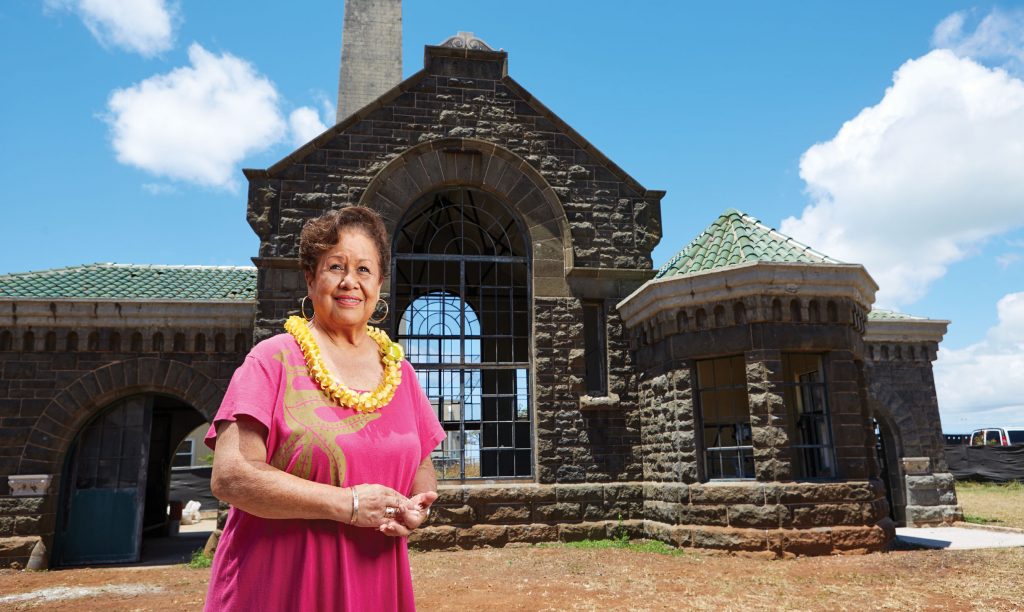
Whether singing, producing CDs, acting, developing Kamehameha School alumni or leading community organizations, Marlene Sai does everything from the heart. Judy Garland onced asked, “When do the words come true?” Marlene turns her love songs into reality by the sheer will of her aloha and proven business savvy. We joined Marlene on the site of her latest project, renovating a 114-year-old building to house a senior center.
The Ka‘akako “pump house” looks so out of place in a forest of towering modern high-rises. For decades, rumors spread that it would be turned into a museum, a restaurant, fine shops or even a car dealership. Now, for the first time in 66 years, Pacific Gateway Center will put this historic industrial building back into use as a community center. This $2.5 million renovation project is supported by an HCDA grant-in-aid and additional funding by the legislature. Remediation of the interior is in progress under the direction of Project Coordinator Marlene Sai, a woman with a reputation for energy, grace, aloha and a remarkable ability to get things done.
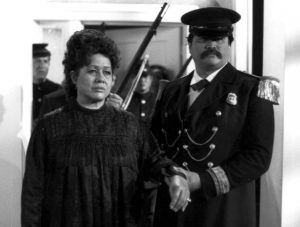
Marlene Sai, an actress, vocalist and music executive, is popularly known as a grand dame of Hawaiian music, whose signature songs “Kainoa” and “Waikīkī,” and portrayal of Lili‘uokalani in the PBS documentary “Betrayal” won her fame and many awards. What many may not know is that Marlene also worked in administration at Kamehameha Schools and built its alumni department, while continuing to perform select “gigs.”
Before balancing work and family was ever mentioned, she was raising her two daughters and in the mainstream of two careers. “I have always been in entertainment and always worked every day in an office — even when I was performing nightly in Waikīkī,” said Marlene. Today, she is driving the Pacific Gateway Center project, Nā Kūpuna Makamae Center, and also leading important community projects, such as Kūpuna Power and the Prince Kuhio Hawaiian Civic Club. She created the Kūpuna Power event with Sen. Brickwood Galuteria in 2012 to educate elders about aging issues and to enrich their lives.
Renovate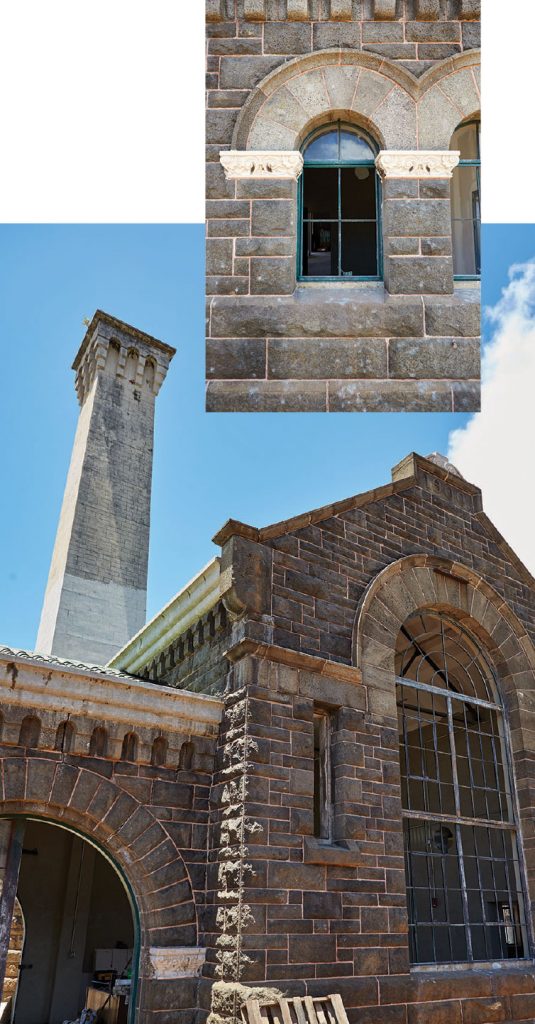
Now officially called “Nā Kūpuna Makamae Senior Center,” the pump house was designed in 1900 by Oliver G. Traphagen (the architect for the main building of the Moana Surf Westin Resort & Spa). The pump station was part of a larger sanitation system engineered for Honolulu by Rudolph Hering from New York City. The tall stack exhausted a huge steam-driven pump housed here. Traphagen balanced the Romanesque exterior of this 1,500-square-foot fortress with large arched windows and a green tile roof that survived well in our climate. This government facility ceased operations in 1949, when all pumping was taken over by the Ala Moana station. In 1978, the old pump station was registered as a historic building; the current construction will not change any of the building’s exterior design features.
One might say that the pump station has been waiting for Nā Kūpuna Makama — The Beloved Seniors. It is a place all seniors recognize and can find their way to on TheBus. Because it is a historic building, it will always be an oasis of open sky and green lawn in Kaka‘ako — a legacy of the past. Later this year, Pacific Gateway Center will open its doors as a community haven for activities that initiate fun: hula, music lessons and performance, yoga, tai chi and movie matinée day, to name a few. Marlene and Marketing Coordinator Valery O’Brien are creating meaningful cultural and educational events that will tell the stories of Hawai‘i, and all her people groups and programs that support and grow our community values.
Follow Your Star
People in Kamehameha Schools at the same time as Marlene said that her music career came up fast. She is from the musical ‘Ikuwā family. In her early teens, her uncle, Andy Cummings, a Hawaiian musician and composer, taught Marlene some of his songs. One was “Kainoa,” a melody he was scoring for his dear friend, Jimmy Lono Tako, a slack key artist on Hawai‘i Island. Her perfect pronunciation of Hawaiian came from her parents and grandparents. If singing with “Uncle” conjurs visions of fancy music studios with monitors, headsets and hanging mics, Marlene will be quick to describe sitting on the front porch after school, with Uncle Andy teaching her his songs, maybe an hour or two every day. He never told her why he was mentoring her; it was just fun — and Marlene loved to sing.
“Our family always had gatherings at our home in Kaimukī, where we would come together to enjoy music — playing instruments, singing and dancing. While I attended Kamehameha Schools, the music influence and structuring with a variety of music was plentiful.”
The key to Marlene is practical grounding. When she graduated from Kamehameha, she got a job working in travel during the summer — earning a living was her priority. “I was on the bottom rung at the agency and pulled Saturday and Sunday shifts. It was OK because I was single. In fact, there were several of us who worked in town on the weekends. Pau hana, we would meet at Joe’s at Waikīkī, near the old Biltmore Hotel, for a snack. We were all just starting out.”
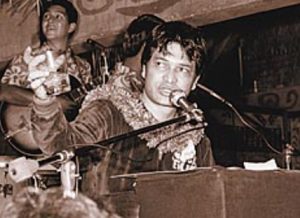
Marlene was a good paddler and knew many of the Waikīkī beach boys. One day, a surfer asked if she and her girlfriends would like to take a ride out to a Kāne‘ohe to a place with good music — Honey’s, a restaurant-bar. “My friend plays good music and manages the place for his mom,” he said. So the next Sunday, they drove over the pali, playing ‘ukulele, singing and laughing the whole way. The 27-year-old entertainer was a fellow named Don Ho. “He was terrific! During the introductions, one of the fellows told Don he should call me up to do a number because ‘this wahine can sing.’ In his kolohe way, Ho said, ‘Yeh — she can sing.’” He did call her to the stage. Marlene sang “Kainoa,” the song her uncle taught her. Ho immediately offered Marlene a part-time job singing at Honey’s — never guessing that she was only 17. She gave him her family’s phone number.
Marlene said Ho never called her, but a few weeks later, he flagged her over as she drove down Kalākaua Avenue. “I lost the number and been looking for you,” he called from his Thunderbird convertible. He asked her to Honey’s the next night — which turned into the start of her recording career. She remembers casually rehearsing with the band — Sonny Chillingworth, Gary ‘Aiko, Tony Bee and Mike Garcia. She did not know that dignitaries of Hawai‘i ’s entertainment industry were in the audience — Bill Murata, George Chun, Herb Ono and Jack deMello — to hear Chillingworth play.
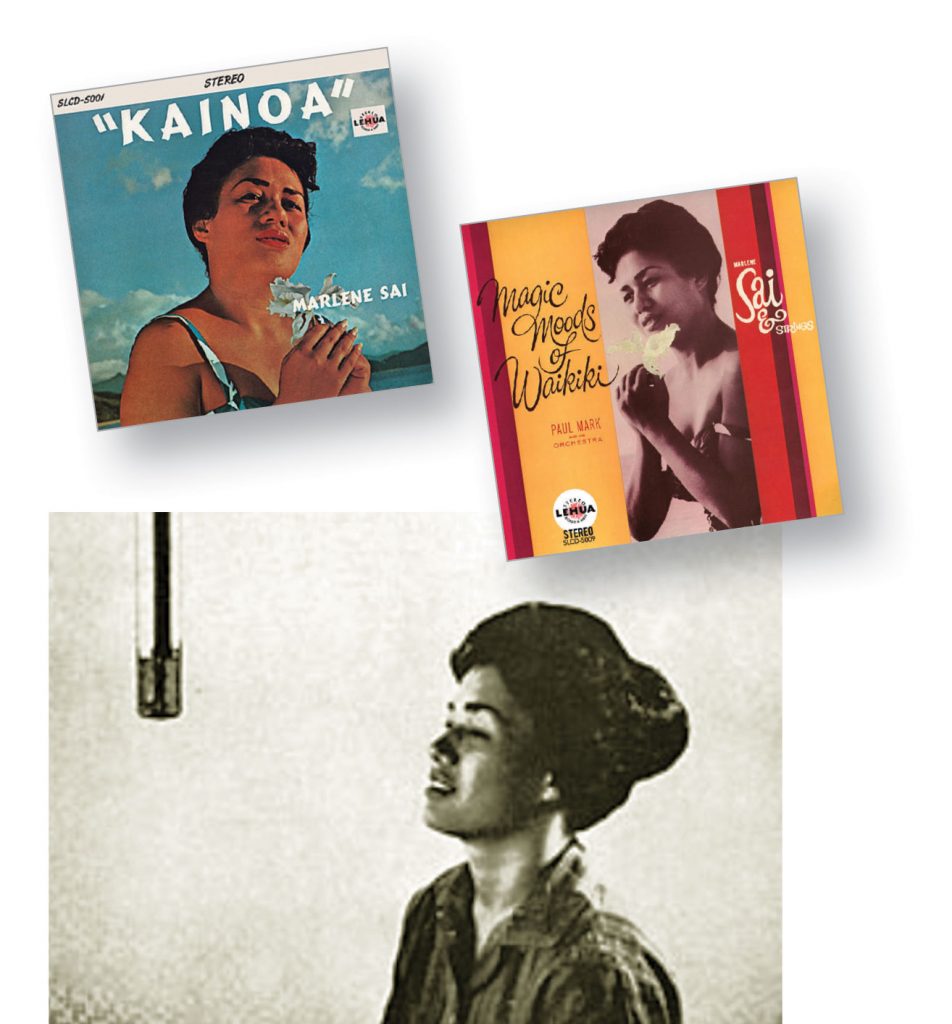
“After I started at Honey’s, my career took off and I decided not to go on to the University of Hawai‘i. When my “Kainoa” album took off, comedian Lucky Luck, disc jockey J. Akuhead Pupule and Jimmy Walker asked me to be on their radio and TV shows… soon I was playing at Duke Kahanamoku’s Supper Club in Waikīkī.”
Put Your Talent to Work
The hit album “Kainoa” wasn’t recorded track by track in a studio. “Sounds of Hawai‘i label was just building a new studio, so we recorded in the Honolulu Rapid Transit bus barn on King Street, where the police department is now. The acoustics were good late at night, when all the traffic died down and the planes stopped flying overhead,” she said. A live performance “air mix” is a desirable sound, but exceedingly difficult to achieve — the whole number must be performed perfectly. Amid all the parked buses, with the help of some of Hawai‘i’s finest musicians — Chillingworth on straight guitar and slack key, Ho on the organ and Alex Among on vibes — Marlene was able to pull it off.
Always the quintessential professional, Marlene said, “It‘s a great story, but I still want to digitize the “Kainoa” project to improve the sound.”
“Kainoa” and “Waikīkī” became her signature songs, later joined by “I Love You,” composed for her by her friend, Teddy Randazzo, an international recording star. In addition to cutting more than 20 albums, she entranced audiences at the biggest Waikīkī hotels — Hilton Hawaiian Village, The Royal Hawaiian Monarch Room, Moana Surf Rider — and supper clubs, such as Don the Beach Comber and Duke Kahanamoku’s.
Marlene said she still misses Ho. They often reminisced about their little-kid days — when everything was fun and exciting. She affectionately called him “Quack,” (relating to Donald Duck) and Marlene’s nickname was “Goofy” because she sometimes likes to joke and act crazy. “We were young and the industry was so big. I had no plan; I was young and fearless and wanted to explore as far as I could go. I was a baby performer working among greats like Genoa Keawe, Haunani Kahalewai, Alfred Apaka, Maddie Lam, Vicky I‘i Rodrigues and Johnny Almeida, to name a few. I was so blessed.”
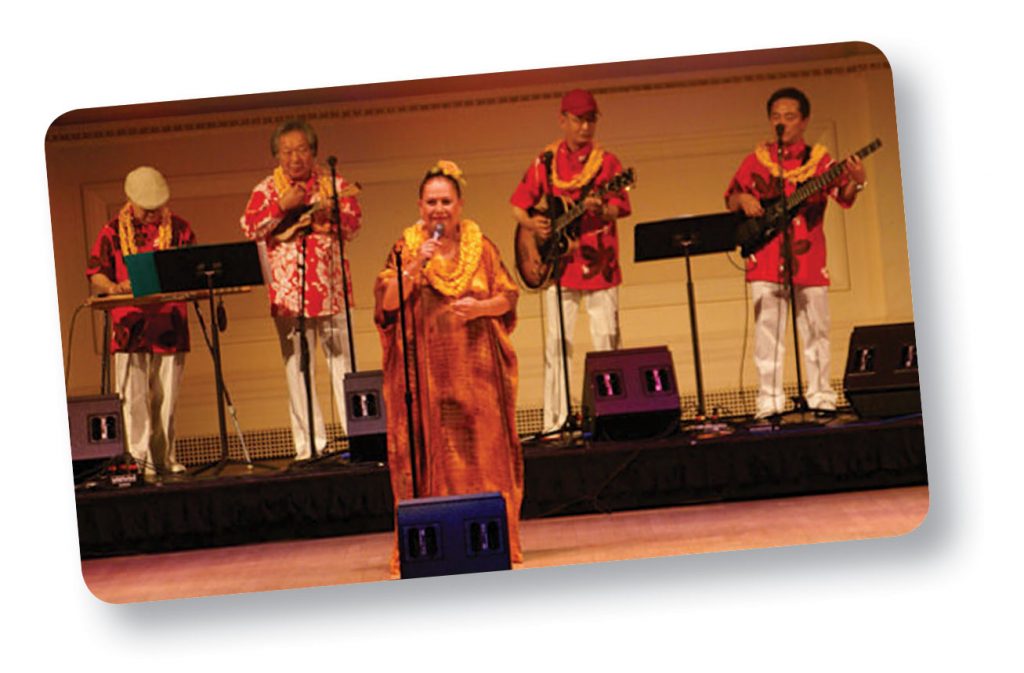
In contrast to the glamor and glitz of stardom, Marlene was wise and eager to learn the gritty entertainment business. She learned as she went, always tackling projects and getting them done. “Donald helped me negotiate a contract at Duke Kahanamoku’s Supper Club with Kimo McVay. After I had recorded with Sounds of Hawaii, I started Makaha Records with friends George Chun and Tom Moffatt. Later on, I got involved with Hawai‘i Academy of Recording Arts as an active board member — I’ve been president three times, treasurer, chair of Nā Hōkū Hanohano Awards a few times — and eventually we took it to the Hawai‘i Convention Center.”
“Respect your gift,” Marlene tells the young entertainers. “The fun comes, but first, you have to treat your business seriously.”
A sober reality of a singing career is meeting your audience where they are. In 1962, Marlene took her first road trip to Japan, where she is still a star. Every spring, she travels west to perform for her fans, backed up by Japanese musicians and hula dancers who specialize in popular Hawaiian music.
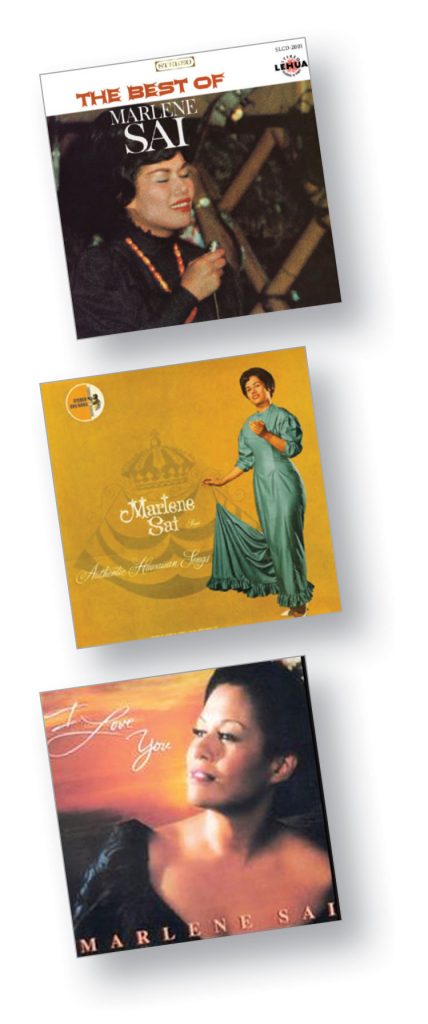
Some Recognition and awards
• 1986 The Hawai’i Academy of Recording Arts (HARA) Nā Hōkū Hanohano Award for “Best Female Vocalist”
• 1987 Hawai‘i State Theatre Council Po‘okela Award for her portrayal of Queen Lili‘uokalani in “Hear Me, O My People”
• 1999 Kamehameha Schools Alumni Gallery Award
• 2004, HARA Nā Hōkū Hanohano Lifetime Achievement Award in music and recording, 2007 Hawaiian Music Foundation Hawaiian Music Hall of Fame Inductee
• Her first LP release, “Kainoa,” was voted “The 50 Greatest Hawai‘i Albums”
Use Your Talent in New Ways
Besides a buttery contralto voice, Marlene has the heart of an actor — an ability to express deep emotions. After her fabulous singing and recording success in the ’60s, acting became one of her most rewarding endeavors. In music, she always asked her composers what inspired their songs and then interpreted that emotion. Her nightly showroom productions always engaged a meaningful storyline. As an actress, she studies her character carefully and “lives” the emotions as they would.
In 1986, she appeared with Tom Selleck as Wahine Luka on “Magnum PI,” and in the next year at Castle Theater, she starred in the Don Berrigan production of “Hear Me O My People,” a one-character play about Queen Lili‘uokalani. So compelling was her portrayal of the queen that Marlene was invited to perform before members of Congress at Folger Shakespeare Theatre in Washington, D.C.

“I was fascinated by the history of the overthrow. In late 1990 or early 1991, Ellen Pelissero, Ted Jung, Edwin Ebisui and I partnered to form Kukui Foundation, a 501(c)(3). Ellen, a professional writer, began researching the historical documents and wrote the original script for a feature documentary. She and I were co-executive producers. Tremaine Tamyose did some script rewrites. He and Joy Chong were co-directors for the production. Shooting was at KHET Manoa Studios. I portrayed Queen Lili‘uokalani. The PBS-Hawaii docudrama “Betrayal” premiered in Hawai‘i on Jan. 17, 1993, on the 100th anniversary of the overthrow of the monarchy.”
Marlene‘s interpretation of the warm-hearted monarch with ali‘i dignity and the humility of a servant of Ke Akua won her a PBS award. According to Television Histories: Shaping Collective Memory in the Media Age, “Betrayal” brought the historical record to the attention of the general public and forever changed popular opinion about Hawaiian sovereignty. Marlene was forever changed, too. “I learned so much I never knew about our Hawaiian history and Lili‘uokalani; for the Kukui Foundation team, the experience was a humbling honor.”
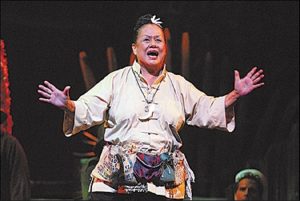
Readers will also remember the 2007 Hawaii Opera Theatre production of “South Pacific,” in which Marlene played the heady Bloody Mary, counseling young lovers to talk “Happy Talk.” She surprised audiences by bringing her keen sense of comedy to the stage, a trait familiar only to family and close friends. The following year, she was back onstage at the Hale Koa Hotel with a review called “This is Hawai‘i.”
Share What You Love
When asked by Leslie Wilcox on KHET’s “Long Story Short” how she views her legacy, Marlene joked, “Legacy? Well, it looks like I’ve been around a long time.” Joking is her way of deflecting praise, but no one can look at her life and fail to recognize the lasting contributions she has made to her extended community. At age 74, she still loves adventure. Whether discovering the business of entertainment and recording, reinventing herself as an actress, developing the alumni department at her alma mater or building a senior center — Marlene has always honored the gifts she was given by using them and exploring ways to put them to good use.
Marlene raised her family with the same discipline that her parents exercised — focusing on the importance of being grounded, earning a living, being fearless and learning all you can. Marlene lives by this rule, researching everything she does and considering all her commitments before she signs a contract. Finding a project worthy of her effort, she forges ahead fearlessly. It is a foundational lesson for her grandchildren. “When my granddaughter was very young, I told her not to be afraid when she performs her hula. Just get up there and share what you love. Speak to the audience through your kuhi and your body.”
Marlene succeeded in raising her family and creating a legacy by building on what she knows, and inventing a future based on her strengths. In a musical family, her talent wasn’t that unusual. When she took it outside, she soon realized she was different. She never gave up her office work, but developed it to the highest level. Today, she is a seasoned administrator in charge of multimillion-dollar project budgets. Her children grew up in the music industry and Marlene recalls her daughter once asking, “Mom, we’re not like other people, are we?” For a seven-year-old, the answer “We are different” might have been dis-appointing, but her mother knew that training in independence and embracing “different” frees the spirit to be creative.
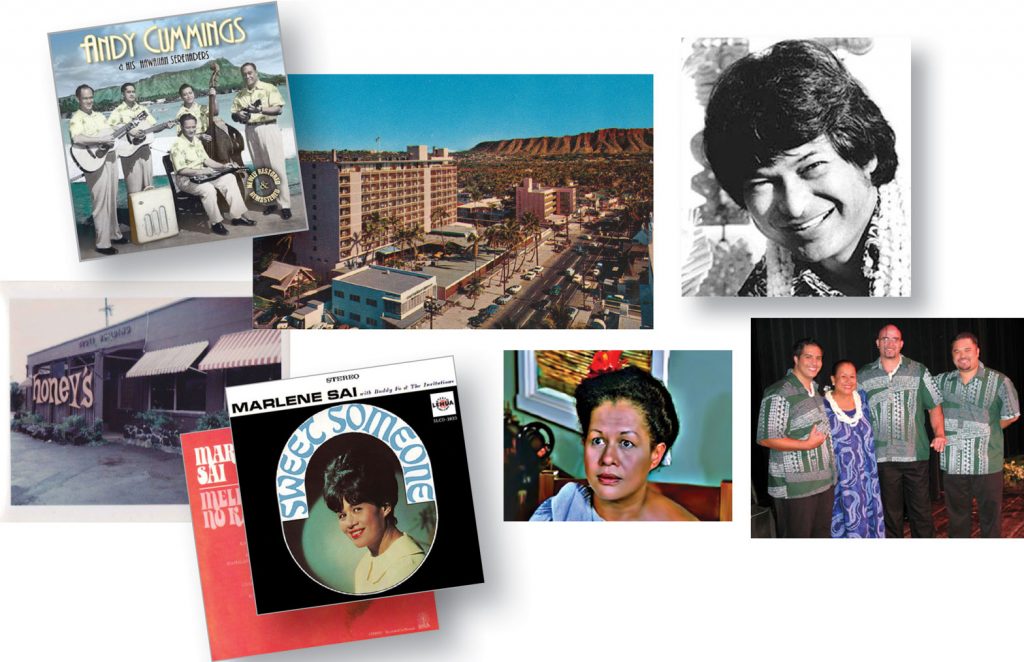
From Marlene Sai’s simple sing-along with her uncle, Andy Cummings, and first vocalist job at Honey’s, came exciting gigs at the old Biltmore Hotel and hit LPs. Later, she began acting but continued to sing, record and serve in trade and community organizations. She still misses Don Ho, cherishes her many friends and associates, and mentors young talented performers.
Invent Your Future
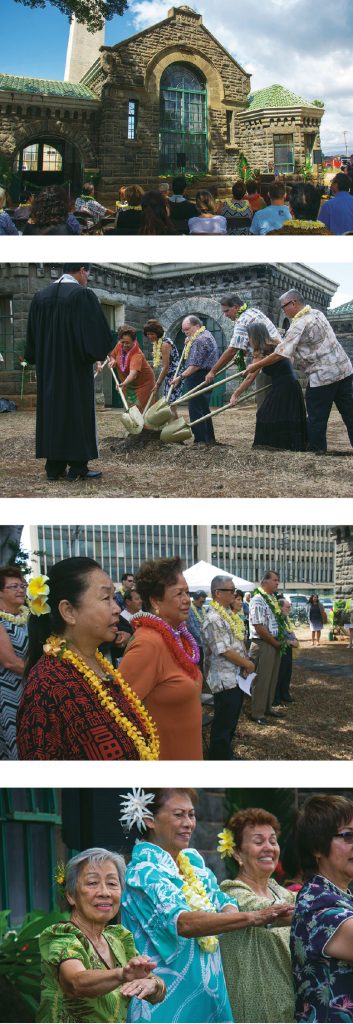
Building a legacy is inventing your future. Marlene loves what she does, and when she finds a project that speaks to her, she commits her time and energy with gusto. And so it is with Nā Kāpuna Makamae. On prime real estate, in an area where elders are underserved, Marlene is helping this nonprofit renovate a historic blue rock building that would cost a fortune to design and build out today. The sewage pump house will be reinvented into an education and creative center where the people of Kaka‘ako can congregate, learn and be inspired to shape their own futures, and follow new dreams.
And even though she loves her challenging “day job” as project and program coordinator, this year, Marlene will also be following the muse she adores — acting in a new Brian Kohne film project called “Kuleana.” This high-concept, feature-length historical drama takes place on Maui in 1971. The film explores a consciousness that preceded the Hawaiian cultural renaissance of the mid-seventies.
Let’s all take a lesson from Marlene Sai and put some thought and energy into inventing the future of our dreams.
Mahalo Nui Loa e Marlene! We love you too!

“It is by looking into the window of your heart that you will find the details of your life.”
— Marlene Sai
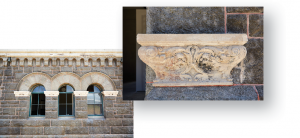


Leave a Reply